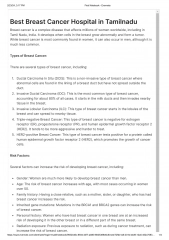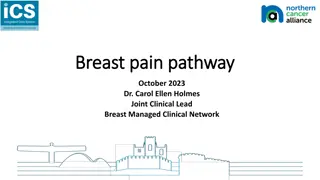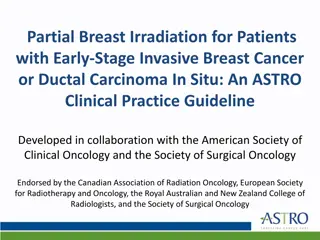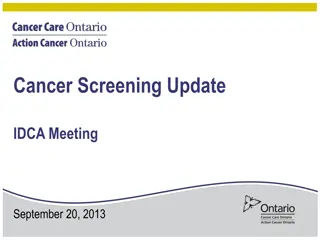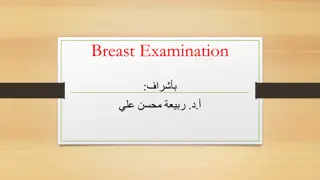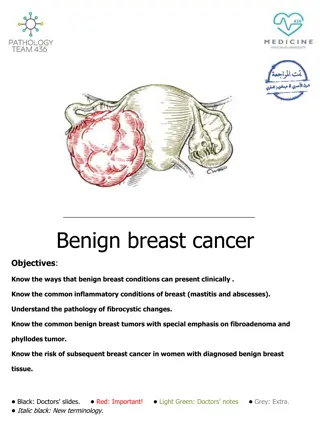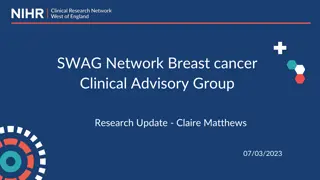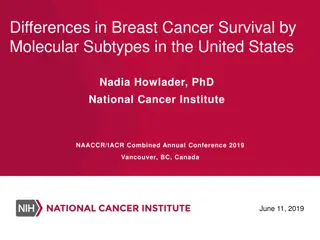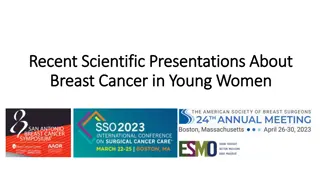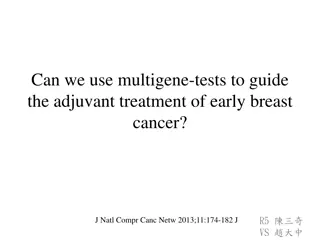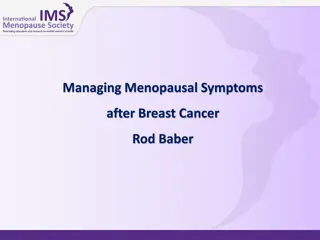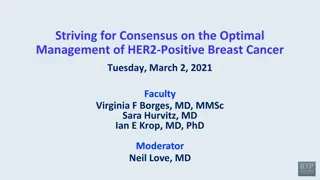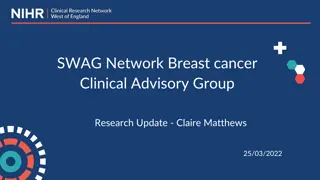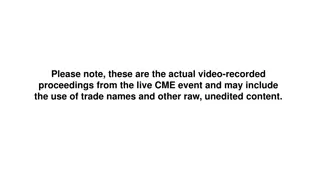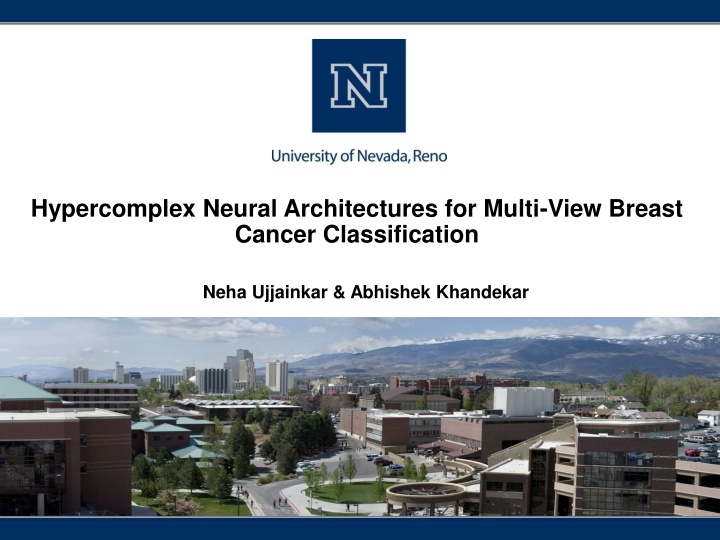
Hypercomplex Neural Architectures for Multi-View Breast Cancer Classification
This study introduces a novel approach for breast cancer classification using hypercomplex neural networks. It explores the benefits of multi-view analysis and proposes models like Quaternion Neural Networks and Parameterized Hypercomplex ResNets. The proposed methods, PHYBOnet and PHYSEnet, aim to enhance the accuracy of classification by processing ipsilateral and bilateral views of breast images.
Download Presentation

Please find below an Image/Link to download the presentation.
The content on the website is provided AS IS for your information and personal use only. It may not be sold, licensed, or shared on other websites without obtaining consent from the author. If you encounter any issues during the download, it is possible that the publisher has removed the file from their server.
You are allowed to download the files provided on this website for personal or commercial use, subject to the condition that they are used lawfully. All files are the property of their respective owners.
The content on the website is provided AS IS for your information and personal use only. It may not be sold, licensed, or shared on other websites without obtaining consent from the author.
E N D
Presentation Transcript
Hypercomplex Neural Architectures for Multi-View Breast Cancer Classification Neha Ujjainkar & Abhishek Khandekar
Outline Introduction Methods Data set Results Advantages Disadvantages Conclusion 2
. Introduction Traditional approach: Deep learning methods for breast cancer classification perform a single-view analysis. Proposed a novel approach: Multi-view breast cancer classification based on a parameterized hypercomplex neural network. 3
. Introduction Issue with multi-path network: The model can favor one of the two views during learning. The model might fail in leveraging the correlated views. Quaternion neural networks (QNNs): Ability to model interactions between input channels. Captures internal latent relations within input channels. Reduces the total number of parameters by almost 75%. 4
. Introduction Parameterized hypercomplex neural networks (PHNNs): Generalize hypercomplex multiplications as a sum of Kronecker products Applicable to any n-dimensional input (instead of just 3D/4D as the quaternion domain) Proposed Method: Parameterized hypercomplex ResNets (PHResNets): - Able to process ipsilateral views corresponding to one breast. 5
. Introduction Proposed Method: PHYBOnet: - Involving a Bottleneck with n = 4, to process learned features in a joint fashion - Able to process bilateral views corresponding to both breast - Perform a patient-level analysis PHYSEnet: - Shared Encoder with n = 2, to learn stronger representations of the ipsilateral views - Shares the weights between bilateral views, - Perform a breast-level analysis. 6
. Multi-View Approach Ipsilateral views (CC and MLO views of the same breast) Helps detect eventual tumors. Bilateral views (same view of both breasts) Helps locate masses (like asymmetries) Radiologists employ a multi-view approach leveraging info from both ipsilateral and bilateral views. 7
. Proposed Method A. Multi-view parameterized hypercomplex ResNet: Leverages information contained in multiple views through parameterized hypercomplex convolutional (PHC) layers. ResNets are used which are characterized by residual connections that ensure proper gradient propagation during training. A ResNets block is typically defined by: y = F(x) + x When equipped with PHC layers F(x) becomes: F(x) = BN (PHC(ReLU (BN (PHC(x))))), 8
. Proposed Method B. Parameterized hypercomplex architectures for two views 9
. Proposed Method C. Parameterized hypercomplex architectures for four views 1) Parameterized Hypercomplex Bottleneck network (PHYBOnet): 10
. Proposed Method C. Parameterized hypercomplex architectures for four views 2) Parameterized Hypercomplex Shared Encoder network (PHYSEnet): 11
. Dataset CBIS-DDSM: employed for the training of the patch classifier as well as the whole-image classifier in the two-view scenario. The images are resized to 600 500 Augmented with a random rotation between 25 and +25 degrees Performed random horizontal and vertical flips INbreast: Consider BI-RADS categories 4, 5, and 6 as positive and 1, 2 as negative The same preprocessing as CBIS-DDSM is applied 12
. Dataset CheXpert: Contains 224,316 chest X-rays with both frontal and lateral views Provides 14 labels for common chest radiographic observations. Images are resized to 320 320 for training The same augmentation operations as before are applied BraTS19: Contains brain MRI scans For training, volumes are resized to 128 128 128 Augmented via random scaling between 1 and 1.1 for the task of overall survival prediction 13
. Evaluation metrics AUC (Area Under the ROC Curve): trade-off between True Positive Rate (TPR) and False Positive Rate (FPR) using different probability thresholds. Classification accuracy: To evaluate the model performance. Dice score: For the segmentation task, which measures the pixel-wise agreement between a predicted mask and its corresponding ground truth 14
. Training Procedure Training challenges: Benign or malignant tumors present very few differences distinguishable only by trained and skilled clinicians. Neural models require huge volumes of data for training. A lesion occupies only a tremendously small portion of the original image. Training strategy: Pretrain the model on patches of mammograms Initializing the network weights with the patch classifier weights and train on whole images. 15
. Training Details Two-view architectures: Added 4 refiner residual blocks with the bottleneck design. The output of such blocks is fed to the final fully connected layer. The backbone network is initialized with the patch classifier weights. the refiner blocks and final layer are trained from scratch. 16
. Training Details Four-view architectures: Parameterized hypercomplex bottleneck network (PHYBOnet): Divide PHResNet18 blocks in such a way that the first part of the network serves as an encoder for each side and the remaining blocks compose the bottleneck. the two outputs are fed to the respective fully connected layer responsible for producing the prediction related to its side. 17
. Training Details Parameterized hypercomplex shared encoder network (PHYSEnet): presents as a shared encoder model a whole PHResNet18 The two classifier branches are comprised of the 4 refiner blocks with a global average pooling layer and the final classification layer. 18
. Experimental evaluation Patch classifier: 19
. Experimental evaluation Experiments with two views : 20
. Experimental evaluation Experiments with four views : 21
. Experimental evaluation Result on CHEXPERT : 22
. Experimental evaluation Result on BRATS19 : 23
. Visualizing Multi-View Learning Visualizing Multi-View Learning: 24
. Advantages Considers ipsilateral views as well as bilateral. Capability of capturing and truly exploiting correlations between views. Reduces the number of free parameters to almost half. The proposed approach is portable and flexible. 25
. Disadvantages Require at least two views. (cannot be used for Single view mammographs) Accuracy needs to be improved further. 26
. Conclusion The proposed approach handles multi-view mammograms as a radiologist does, thus leveraging information contained in ipsilateral views as well as bilateral. Leveraging hypercomplex algebra properties, neural models are endowed with the capability of capturing and truly exploiting correlations between views. This study paves the way for novel methods capable of processing medical imaging exams with techniques closer to radiologists and human understanding. 27
. Future Improvements Utilizing a larger image training data set. Optimizing hyperparameters including the batch size and cross-validation. The model could employ a different base architecture (instead of ResNet18 and ResNet50). Investigate some other evaluation and visualization metrics. 28
References 1. R. L. Siegel, K. D. Miller, H. E. Fuchs, and A. Jemal, Cancer statistics, 2022, CA: A Cancer Journal for Clinicians, vol. 72, no. 1, pp. 7 33, 2022. 2. I. C. Moreira, I. Amaral, I. Domingues, A. Cardoso, M. J. Cardoso, and J. S. Cardoso, INbreast: Toward a full-field digital mammographic database, Academic Radiology, vol. 19, no. 2, pp. 236 248, 2012 3. S. Misra, N. L. Solomon, F. L. Moffat, and L. G. Koniaris, Screening criteria for breast cancer, Adv. Surg., vol. 44, pp. 87 100, 2010. 4. D. Gur, G. S. Abrams, D. M. Chough, M. A. Ganott, C. M. Hakim, R. L. Perrin, G. Y. Rathfon, J. H. Sumkin, M. L. Zuley, and A. I. Bandos, Digital breast tomosynthesis: Observer performance study, American Journal of Roentgenology, vol. 193, no. 2, pp. 586 591, 2009. 5. Y. Liu, F. Zhang, C. Chen, S. Wang, Y. Wang, and Y. Yu, Act like a radiologist: Towards reliable multi-view correspondence reasoning for mammogram mass detection, IEEE Trans. Pattern Anal. Mach. Intell., no. 01, pp. 1 1, 2021. 6. L. Shen, L. Margolies, J. Rothstein, E. Fluder, R. McBride, and W. Sieh, Deep learning to improve breast cancer detection on screening mammography, Sci. Rep., vol. 9, 2019. 7. N. Wu, Z. Huang, Y. Shen, J. Park, J. Phang, T. Makino, S. Kim, K. Cho, L. Heacock, L. Moy, and K. J. Geras, Reducing false- positive biopsies using deep neural networks that utilize both local and global image context of screening mammograms, Journal of Digital Imaging, vol. 34, pp. 1414 1423, 2021. 8. G. Murtaza, L. Shuib, A. Wahid, G. Mujtaba, H. Nweke, M. Al-Garadi, F. Zulfiqar, G. Raza, and N. Azmi, Deep learning-based breast cancer classification through medical imaging modalities: state of the art an 9. D. Abdelhafiz, C. Yang, R. Ammar, and S. Nabavi, Deep convolutional neural networks for mammography: advances, challenges and applications, BMC Bioinformatics, vol. 20, 2019. 10. S. S. Aboutalib, A. A. Mohamed, W. A. Berg, M. L. Zuley, J. H. Sumkin, and S. Wu, Deep Learning to Distinguish Recalled but Benign Mammography Images in Breast Cancer Screening, Clinical Cancer Research, vol. 24, no. 23, pp. 5902 5909, 2018. 29
. Thank You 30

